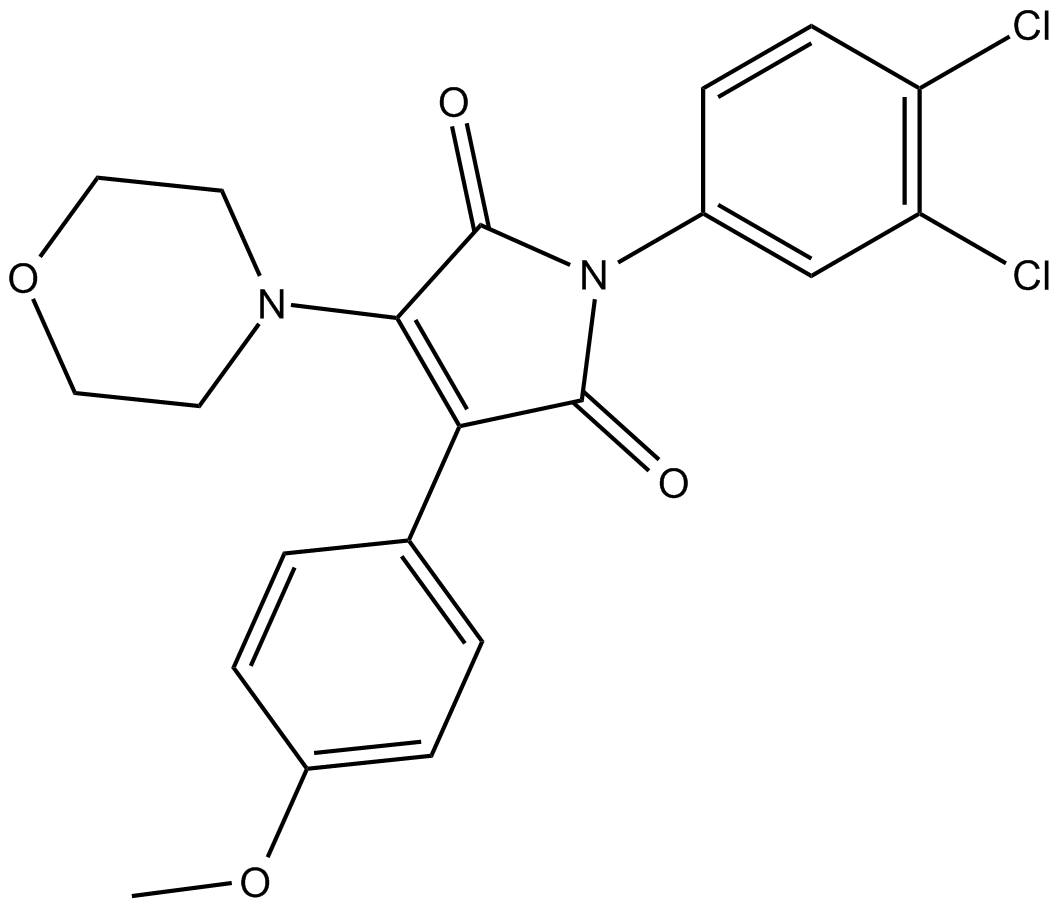RI-2 |
| Katalog-Nr.GC12752 |
RI-2 ist ein reversibler RAD51-Inhibitor mit einem IC50-Wert von 44,17 μM und hemmt spezifisch die homologe Rekombinationsreparatur in menschlichen Zellen.
Products are for research use only. Not for human use. We do not sell to patients.

Cas No.: 1417162-36-7
Sample solution is provided at 25 µL, 10mM.
Description:
IC50: 44.17 μM
Homologous recombination (HR) is an essential process in cells that provides repair of DNA double-strand breaks and lesions that block DNA replication. RAD51 is an evolutionarily conserved protein that is central to HR. Overexpression of RAD51 protein is common in cancer cells and represents a potential therapeutic target in oncology. RI-2 is an optimized reversible RAD51 inhibitor.
In vitro: Although RI-2 did exhibit reduced activity relative to RI-1, it did retain enough activity to sensitize cells to MMC cell-based assays. RI-2 exhibited no reactivity toward glutathione after incubation for 24 hours. RAD51 protein that had been treated with RI-2 prior to washing exhibited no measurable loss of DNA binding activity, even though RI-2 is known to inhibit RAD51 with an IC50 of 44.17 μM. This indicates that RAD51 inhibition by RI-2 is fully reversible [1].
In vivo: RI-1, the analogue of RI-2, facilitated mapping of the binding pocket within known crystal structures of RAD51. However, this reactivity of RI-1 potentially may limit its development in pre-clinical animal models. RI-1 has been found to exhibit a relatively short half-life, due to reactivity in thiol-containing solutions [1].
Clinical trial: Up to now, RI-2 is still in the preclinical development stage.
Reference:
[1] Budke B, Kalin JH, Pawlowski M, Zelivianskaia AS, Wu M, Kozikowski AP, Connell PP. An optimized RAD51 inhibitor that disrupts homologous recombination without requiring Michael acceptor reactivity. J Med Chem. 2013 Jan 10;56(1):254-63.
Cell experiment: | HEK293 cells are plated into 96-well tissue culture plates at a density of 300 cells per well in the presence or absence of 50 nM mitomycin C (MMC) for 24 hours at 37°C, 5% CO2. Media is subsequently replaced with fresh media containing 0.5% DMSO plus RI-2 for an additional 24 hours. RI-2 is then removed, and cultures are allowed to grow to a 50-70% confluence. Average survival from at least three replicates is measured using CellGlo reagentor. RI-2 is deemed successful in sensitizing cells to MMC if they generate significantly greater toxicity in the presence of MMC relative to the absence of MMC. Specifically, sensitization is scored as a “+” when non-overlapping standard errors are observed for at least two pairs of compound doses[1]. |
References: [1]. Budke B, et al. An optimized RAD51 inhibitor that disrupts homologous recombination without requiring Michael acceptor reactivity. J Med Chem. 2013 Jan 10;56(1):254-63. | |
| Cas No. | 1417162-36-7 | SDF | |
| Chemical Name | 1-(3,4-dichlorophenyl)-3-(4-methoxyphenyl)-4-morpholino-1H-pyrrole-2,5-dione | ||
| Canonical SMILES | COC1=CC=C(C(C(N2C3=CC(Cl)=C(Cl)C=C3)=O)=C(N4CCOCC4)C2=O)C=C1 | ||
| Formula | C21H18Cl2N2O4 | M.Wt | 433.28 |
| Löslichkeit | ≥ 21.65mg/mL in DMSO | Storage | Store at -20°C |
| General tips | Please select the appropriate solvent to prepare the stock solution according to the
solubility of the product in different solvents; once the solution is prepared, please store it in
separate packages to avoid product failure caused by repeated freezing and thawing.Storage method
and period of the stock solution: When stored at -80°C, please use it within 6 months; when stored
at -20°C, please use it within 1 month. To increase solubility, heat the tube to 37°C and then oscillate in an ultrasonic bath for some time. |
||
| Shipping Condition | Evaluation sample solution: shipped with blue ice. All other sizes available: with RT, or with Blue Ice upon request. | ||
| Prepare stock solution | |||

|
1 mg | 5 mg | 10 mg |
| 1 mM | 2.308 mL | 11.5399 mL | 23.0798 mL |
| 5 mM | 0.4616 mL | 2.308 mL | 4.616 mL |
| 10 mM | 0.2308 mL | 1.154 mL | 2.308 mL |
Step 1: Enter information below (Recommended: An additional animal making an allowance for loss during the experiment)
 g
g
 μL
μL

Step 2: Enter the in vivo formulation (This is only the calculator, not formulation. Please contact us first if there is no in vivo formulation at the solubility Section.)
Calculation results:
Working concentration: mg/ml;
Method for preparing DMSO master liquid: mg drug pre-dissolved in μL DMSO ( Master liquid concentration mg/mL, Please contact us first if the concentration exceeds the DMSO solubility of the batch of drug. )
Method for preparing in vivo formulation: Take μL DMSO master liquid, next addμL PEG300, mix and clarify, next addμL Tween 80, mix and clarify, next add μL ddH2O, mix and clarify.
Method for preparing in vivo formulation: Take μL DMSO master liquid, next add μL Corn oil, mix and clarify.
Note: 1. Please make sure the liquid is clear before adding the next solvent.
2. Be sure to add the solvent(s) in order. You must ensure that the solution obtained, in the previous addition, is a clear solution before proceeding to add the next solvent. Physical methods such as vortex, ultrasound or hot water bath can be used to aid dissolving.
3. All of the above co-solvents are available for purchase on the GlpBio website.
Quality Control & SDS
- View current batch:
- Purity: >99.50%
- COA (Certificate Of Analysis)
- SDS (Safety Data Sheet)
- Datasheet
Average Rating: 5 (Based on Reviews and 23 reference(s) in Google Scholar.)
GLPBIO products are for RESEARCH USE ONLY. Please make sure your review or question is research based.
Required fields are marked with *



















